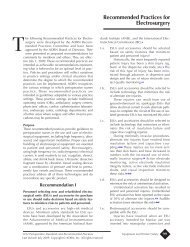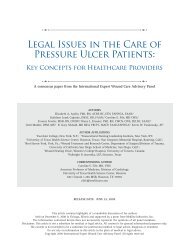2009 CAUTI guidelines - Centers for Disease Control and Prevention
2009 CAUTI guidelines - Centers for Disease Control and Prevention
2009 CAUTI guidelines - Centers for Disease Control and Prevention
You also want an ePaper? Increase the reach of your titles
YUMPU automatically turns print PDFs into web optimized ePapers that Google loves.
Data Extraction <strong>and</strong> SynthesisData on the study author, year, design, objective, population, setting, sample size, power,follow-up, <strong>and</strong> definitions <strong>and</strong> results of clinically relevant outcomes were extracted intoevidence tables (Appendix 2). Three evidence tables were developed, each of whichrepresented one of our key questions. Studies were extracted into the most relevant evidencetable. Then, studies were organized by the common themes that emerged within each evidencetable. Data were extracted by one author (R.K.A.) <strong>and</strong> cross-checked by another (C.V.G.).Disagreements were resolved by the remaining authors. Data <strong>and</strong> analyses were extracted asoriginally presented in the included studies. Meta-analyses were per<strong>for</strong>med only where their usewas deemed critical to a recommendation, <strong>and</strong> only in circumstances where multiple studieswith sufficiently homogenous populations, interventions, <strong>and</strong> outcomes could be analyzed.Systematic reviews were included in our review. To avoid duplication of data, we excludedprimary studies if they were also included in a systematic review captured by our search. Theonly exception to this was if the primary study also addressed a relevant question that wasoutside the scope of the included systematic review. Be<strong>for</strong>e exclusion, data from the primarystudies that we originally captured were abstracted into the evidence tables <strong>and</strong> reviewed. Wealso excluded systematic reviews that analyzed primary studies that were fully captured in amore recent systematic review. The only exception to this was if the older systematic reviewalso addressed a relevant question that was outside the scope of the newer systematic review.To ensure that all relevant studies were captured in the search, the bibliography was vetted by apanel of clinical experts.Grading of EvidenceFirst, the quality of each study was assessed using scales adapted from existing methodologychecklists, <strong>and</strong> scores were recorded in the evidence tables. Appendix 3 includes the sets ofquestions we used to assess the quality of each of the major study designs. Next, the quality ofthe evidence base was assessed using methods adapted from the GRADE Working Group. 32Briefly, GRADE tables were developed <strong>for</strong> each of the interventions or questions addressedwithin the evidence tables. Included in the GRADE tables were the intervention of interest, anyoutcomes listed in the evidence tables that were judged to be clinically important, the quantity<strong>and</strong> type of evidence <strong>for</strong> each outcome, the relevant findings, <strong>and</strong> the GRADE of evidence <strong>for</strong>each outcome, as well as an overall GRADE of the evidence base <strong>for</strong> the given intervention orquestion. The initial GRADE of evidence <strong>for</strong> each outcome was deemed high if the evidencebase included a r<strong>and</strong>omized controlled trial (RCT) or a systematic review of RCTs, low if theevidence base included only observational studies, or very low if the evidence base consistedonly of uncontrolled studies. The initial GRADE could then be modified by eight criteria. 34Criteria which could decrease the GRADE of an evidence base included quality, consistency,directness, precision, <strong>and</strong> publication bias. Criteria that could increase the GRADE included alarge magnitude of effect, a dose-response gradient, or inclusion of unmeasured confoundersthat would increase the magnitude of effect (Table 3). GRADE definitions are as follows:1. High - further research is very unlikely to change confidence in the estimate of effect2. Moderate - further research is likely to affect confidence in the estimate of effect <strong>and</strong>may change the estimate3. Low - further research is very likely to affect confidence in the estimate of effect <strong>and</strong> islikely to change the estimate4. Very low - any estimate of effect is very uncertain29
















